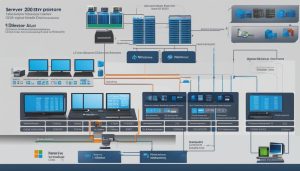Welcome to our comprehensive guide on DirectX! If you’ve ever wondered what DirectX is, how it works, and what it can do, you’ve come to the right place. In this guide, we will delve into the world of DirectX, exploring its definition, features, benefits, and more. Whether you’re a developer looking to understand the basics of DirectX or a curious individual seeking a deeper understanding of this technology, we’ve got you covered.
Key Takeaways:
- DirectX is an application programming interface (API) developed by Microsoft for Windows and Xbox.
- It provides a set of APIs for creating high-performance multimedia applications, particularly in the area of graphics.
- DirectX includes support for both 2D and 3D graphics, enabling developers to create visually stunning games and multimedia applications.
- DirectX 12 Ultimate is the latest version, offering advanced features like ray tracing and variable rate shading.
- By leveraging DirectX, developers can unlock the full graphical potential of their applications and deliver superior experiences.
Introduction to DirectX Graphics
DirectX graphics is a critical component of the DirectX framework, specifically designed to empower developers in creating high-performance multimedia applications with stunning visuals. It offers a collection of APIs catering to both 2D and 3D graphics, enabling developers to craft immersive and visually captivating experiences.
With DirectX graphics, developers gain access to a range of tools and functionalities that allow for the rendering of 2D geometry, bitmaps, and text with exceptional quality and performance. This comprehensive suite of APIs is a fundamental resource for game developers and creators of other multimedia applications who seek to harness the potential of modern GPUs.
The capabilities provided by DirectX graphics extend beyond mere image rendering. It enables developers to tap into hardware acceleration, utilizing the power of graphics processing units (GPUs) to deliver realistic and visually stunning graphics. By leveraging DirectX graphics, developers can unlock the full potential of hardware-accelerated 2D and 3D graphics, enriching the user experience and immersing them in a world of interactive multimedia.
Advantages of DirectX Graphics:
- Support for both 2D and 3D graphics.
- High-quality rendering of geometry, bitmaps, and text.
- Hardware acceleration for realistic and immersive graphics.
- Utilizes the power of modern GPUs.
Key Features of DirectX Graphics:
- Support for 2D geometry rendering.
- High-performance bitmap and text rendering.
- Ability to leverage hardware acceleration for 3D graphics.
- Integration with modern GPUs to deliver visually stunning visuals.
| DirectX Graphics APIs | Description |
|---|---|
| Direct2D | API for hardware-accelerated 2D graphics rendering. |
| Direct3D | API for high-performance 3D graphics rendering. |
| DXCore | API for developing DirectX extensions and tools. |
| DirectWrite | API for high-quality text rendering. |
| DirectStorage | API for optimizing IO performance in game development. |
| DirectXMath | API for mathematical operations in graphics programming. |
| DirectML | API for machine learning operations on GPUs. |
| WindowsNumerics.h | API for advanced mathematical operations in Windows apps. |
The Role of COM in Programming DirectX
In the world of DirectX programming, the Component Object Model (COM) plays a significant role. COM is an object-oriented programming model utilized by various technologies, including the DirectX API surface. It provides a standardized approach for interacting with COM-based components, enabling developers to create and utilize objects consistently and efficiently.
Developers can leverage the DirectX API surface, built on top of COM, to access a wide range of functionalities and features for creating graphics-intensive applications with DirectX. This powerful combination allows developers to tap into the full potential of DirectX and unleash their creativity in building visually captivating and high-performance multimedia applications.
By utilizing COM, developers can take advantage of the modularity and extensibility that it offers. This allows for the seamless integration of different components within an application, facilitating collaboration and enhancing the overall development process. COM provides a robust foundation for programming DirectX, enabling developers to harness the power of this API and deliver immersive experiences to users.
Diving into COM
COM operates on the principle of interface-based programming, where components expose interfaces that define a set of methods and properties. Developers can utilize these interfaces to interact with the components and leverage their functionality. This level of abstraction provided by COM allows for flexibility and compatibility, making it easier to develop and maintain DirectX applications.
One of the key benefits of COM is its support for reusability. Developers can create COM-based components that encapsulate specific functionality and reuse them across different projects. This promotes code efficiency and reduces development time, allowing developers to focus on implementing unique features and optimizing performance.
Furthermore, COM ensures memory management and object lifetime through reference counting. Developers can create and release COM objects without having to worry about manual memory allocation and deallocation. This approach simplifies memory management and reduces the risk of memory leaks, making the development process more robust and reliable.
Overall, COM plays a critical role in programming DirectX applications. It provides a powerful foundation for interacting with DirectX API surface, enabling developers to create high-performance multimedia applications with ease. By leveraging COM’s modularity, reusability, and memory management capabilities, developers can unlock the full potential of DirectX and deliver visually stunning experiences to users.
Exploring DirectX Graphics APIs
DirectX graphics encompasses various APIs that developers can utilize to harness the power of DirectX. These APIs provide a wide range of functionalities and features for creating visually immersive experiences. Let’s explore some of the key DirectX graphics APIs:
1. Direct2D
Direct2D is a 2D graphics API that enables developers to create high-quality, hardware-accelerated 2D graphics. It allows for efficient rendering of text, shapes, and images, making it a valuable tool for creating visually appealing user interfaces and graphics-intensive applications.
2. Direct3D
Direct3D is the most well-known API within DirectX and is used for creating 3D graphics applications, particularly games. It provides developers with advanced rendering capabilities, allowing them to leverage the full potential of modern GPUs. With Direct3D, developers can create stunning visual effects, realistic simulations, and immersive virtual worlds.
To support the development of DirectX graphics applications, Microsoft provides additional APIs and libraries:
- DXCore: DXCore is a set of utility libraries that provide common functionalities, such as memory management and debugging tools, to assist developers in building DirectX applications efficiently.
- DirectWrite: DirectWrite is a typography API that enables high-quality text rendering, allowing developers to create visually appealing and readable text in their applications.
- DirectStorage: DirectStorage is a recently introduced API that allows for faster loading and streaming of game assets from storage devices, reducing load times and improving overall performance.
- DirectXMath: DirectXMath is a library that provides optimized mathematical functions and operations for graphics programming, helping developers perform complex calculations efficiently.
- DirectML: DirectML is a machine learning API that leverages the power of GPUs to accelerate machine learning tasks, enabling developers to integrate AI capabilities into their DirectX applications.
- WindowsNumerics.h: WindowsNumerics.h is a header file that provides numerical functions and types for graphics and physics calculations, making it easier for developers to work with mathematical operations in DirectX applications.
These DirectX graphics APIs empower developers to create visually stunning and high-performance applications, unlocking the full potential of modern graphics hardware.
| API | Description |
|---|---|
| Direct2D | A 2D graphics API for creating high-quality hardware-accelerated graphics. |
| Direct3D | A 3D graphics API used for creating visually immersive experiences, especially in games. |
| DXCore | A set of utility libraries that provide common functionalities for DirectX application development. |
| DirectWrite | A typography API for high-quality text rendering in DirectX applications. |
| DirectStorage | An API for faster loading and streaming of game assets, improving overall performance. |
| DirectXMath | A library providing optimized mathematical functions for graphics programming. |
| DirectML | A machine learning API for integrating AI capabilities into DirectX applications. |
| WindowsNumerics.h | A header file providing numerical functions and types for mathematical operations in DirectX applications. |
Understanding DirectX and Game Development
DirectX plays a crucial role in game development by providing developers with the necessary tools and APIs to create visually stunning and high-performance games. With DirectX, developers can tap into the hardware acceleration capabilities of modern GPUs, unlocking the potential for realistic and immersive graphics.
One of the key benefits of using DirectX in game development is its support for both 2D and 3D graphics. This allows developers to create games that can display stunning visuals and offer a truly immersive gaming experience. Whether it’s rendering lifelike environments in a first-person shooter or creating vibrant characters in a role-playing game, DirectX empowers developers to bring their game worlds to life.
Hardware acceleration is another important aspect of DirectX in game development. By leveraging the power of modern GPUs, games can achieve smooth and responsive gameplay, even in visually demanding scenarios. DirectX enables developers to take advantage of features like hardware-accelerated ray tracing, which allows for more realistic lighting and reflections, enhancing the overall visual fidelity of games.
Overall, DirectX provides game developers with a comprehensive set of tools and APIs to optimize performance, leverage hardware acceleration, and create visually stunning games. With its support for both 2D and 3D graphics, DirectX empowers developers to unleash their creativity and deliver exceptional gaming experiences to players.
The power of DirectX in game development
| Feature | Benefits |
|---|---|
| Support for 2D and 3D graphics | Enables the creation of visually stunning game worlds |
| Hardware acceleration | Delivers smooth and responsive gameplay |
| Hardware-accelerated ray tracing | Enhances visual fidelity with realistic lighting and reflections |
| Optimization tools | Helps developers fine-tune performance for optimal gaming experiences |
DirectX and Graphics Card Compatibility
When working with DirectX, compatibility with your graphics card is crucial. DirectX is designed to be backward compatible, meaning that newer versions of DirectX can support games and applications created with older versions. However, it is generally recommended to use the latest supported version of DirectX to take advantage of improved features and performance optimizations.
Graphics card manufacturers, such as AMD and Nvidia, provide drivers that are compatible with DirectX. These drivers ensure that your graphics card can properly communicate with DirectX and provide the necessary hardware acceleration for your applications. By keeping your graphics card drivers up to date, you can ensure optimal performance and compatibility with DirectX.
It’s important to note that different versions of DirectX may have varying requirements for specific features or functionalities. When developing or using applications that utilize DirectX, it’s essential to check the DirectX version required by the game or application. This information can typically be found in the system requirements or documentation provided by the application developers.
| DirectX Version | Year of Release | Windows Version Support |
|---|---|---|
| DirectX 11 | 2009 | Windows 7 and later |
| DirectX 12 | 2015 | Windows 10 and later |
| DirectX 12 Ultimate | 2020 | Windows 10 and later |
As shown in the table above, DirectX 11 was released in 2009 and supports Windows 7 and later versions. DirectX 12, introduced in 2015, is compatible with Windows 10 and later versions. The latest version, DirectX 12 Ultimate, was released in 2020 and also supports Windows 10 and later versions.
By ensuring that your graphics card supports the required DirectX version, you can enjoy the full potential of DirectX’s features and capabilities. Additionally, keeping your graphics card drivers up to date will further enhance compatibility and performance when working with DirectX.
Conclusion
DirectX is a powerful application programming interface (API) developed by Microsoft for Windows and Xbox platforms. With DirectX, developers can create visually stunning and high-performance multimedia applications, particularly in the area of graphics.
By utilizing DirectX graphics, developers have access to a comprehensive set of tools and APIs for creating both 2D and 3D graphics. This includes support for rendering high-quality 2D geometry, bitmaps, and text, as well as harnessing the capabilities of modern GPUs for immersive 3D experiences.
One of the major benefits of DirectX is its ability to leverage hardware acceleration, allowing developers to tap into the graphical capabilities of GPUs. This results in realistic and visually engaging graphics that enhance the overall experience for users.
Overall, DirectX is an essential tool for game developers and creators of multimedia applications. With its latest version, DirectX 12 Ultimate, offering advanced features like ray tracing and variable rate shading, developers can unlock the full potential of modern GPUs and deliver exceptional graphical experiences on Windows platforms.
FAQ
What is DirectX?
DirectX is an application programming interface (API) developed by Microsoft for Windows and Xbox. It provides a set of APIs that allow developers to create high-performance multimedia applications, particularly in the area of graphics.
What is DirectX Graphics?
DirectX graphics is a component of DirectX that provides a collection of APIs specifically designed for creating high-performance multimedia applications. With DirectX graphics, developers have access to APIs for both 2D and 3D graphics, allowing them to create visually immersive experiences.
What is the role of COM in programming DirectX?
In DirectX programming, the Component Object Model (COM) plays a significant role. COM is an object-oriented programming model used by several technologies, including the DirectX API surface. It provides a standardized way for interacting with COM-based components, allowing developers to create and use objects in a consistent and efficient manner.
What are some DirectX Graphics APIs?
DirectX graphics encompasses various APIs that developers can utilize to harness the power of DirectX. These APIs include Direct2D, Direct3D, DXCore, DirectWrite, DirectStorage, DirectXMath, DirectML, and WindowsNumerics.h APIs.
How does DirectX contribute to game development?
DirectX plays a crucial role in game development by providing developers with the necessary tools and APIs to create visually stunning and high-performance games. It enables developers to tap into the hardware acceleration capabilities of modern GPUs, allowing for realistic and immersive graphics.
Is DirectX backward compatible?
Yes, DirectX is designed to be backward compatible, meaning that newer versions can support games and applications created with older versions. It is generally recommended to use the latest supported version of DirectX to take advantage of improved features and performance optimizations.
Do I need specific drivers for DirectX compatibility?
Graphics card manufacturers like AMD and Nvidia provide drivers that are compatible with DirectX. This allows developers to create applications without having to worry about specific drivers for different graphics cards. However, it’s important to ensure that your graphics card supports the DirectX version required by the game or application you intend to use.
Janina is a senior specialist in information technology


